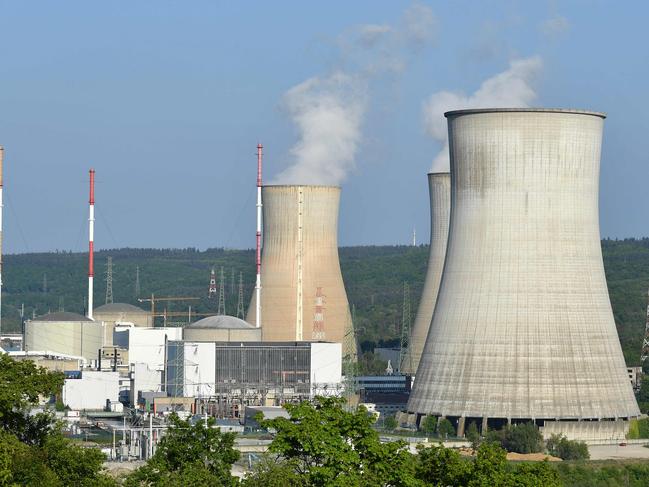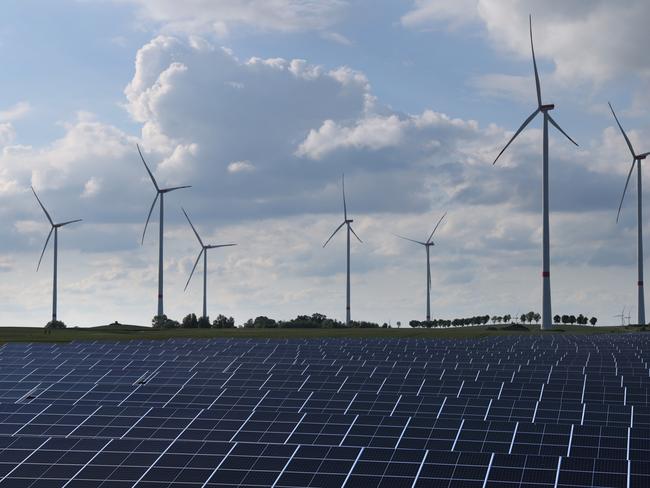New research reveals when it comes to cost, nuclear power is the cheapest option
New data on the corrected costs of nuclear power, renewable wind and solar, gas and coal show that nuclear energy is cheaper than the other power sources, writes Piers Akerman.
NSW
Don't miss out on the headlines from NSW. Followed categories will be added to My News.
The federal government may be forced to review its ban on nuclear energy with the release of new data on energy costs and growing pressure from within the trade union movement.
New figures on the corrected costs of nuclear power, renewable wind and solar, gas and coal show that nuclear energy is cheaper than the other power sources.
When the capacity factor, the estimated plant lifetime, transmission costs and other relevant factors are considered, the cost of building nuclear power stations to replace the nation’s ageing coal-fired plants is cheaper than wind and solar and vastly more efficient than reliance on giant batteries or pumped hydro, according to Tony Irwin, a nuclear engineer with SMR Nuclear Technology.

Nuclear-generated power comes in at $5596/kW, large-scale solar at more than $14,882/kW, wind at more than $12,372kW and fossil fuels (gas and coal with carbon capture and storage) at between $10,280/kW and $10,000/kW, by Irwin’s calculation.
His experience in the industry includes 30 years operating large scale nuclear power plants in the UK and he is a former reactor manager of ANSTO’s Lucas Heights nuclear plant.
A fortnight ago, Energy Minister Chris Bowen described nuclear energy as “a complete joke”.
“Nuclear is the most expensive form of energy. We have a cost-of-living crisis. Energy prices are going through the roof – and that’s the big, bright idea? Let’s have the most expensive form of energy we can possibly think of?” he said. “It’s a complete joke.”

Since then, Prime Minister Anthony Albanese has announced new emissions reduction targets of 43 per cent by 2030, relying on yet-to-be built wind and solar and a new transmission network costing tens of billions.
The new costings comparison comes with the general release of a hard-hitting paper titled Nuclear Power Through The Lens Of An Australian Trade Union, written for the independent Energy Policy Institute of Australia by Geoff Dyke, who was, until his death in April, Victorian branch secretary of the mining and energy division of the CFMEU.

In part, it says: “Nuclear power is a proven choice of a dispatchable and economically viable, zero greenhouse gas emission power generation technology available today”.
He was arguing for the replacement of the Latrobe Valley’s coal-fired power stations with new small modular reactors (SMR) and the employment of his union members in the nuclear plants when their jobs in coal-fired plants were lost.
The CMFEU represents power station workers and coal miners in Victoria and NSW.
Numbers all up to a nuclear future
Comment by Piers Akerman
New data on costs has smashed the argument for major investment in renewable energy and shown that nuclear is the cheapest and most reliable means to go green safely.
Wind and solar, backed by super-batteries or pumped hydro, are grotesquely expensive projects that do not and cannot meet Australia’s energy needs in the near or even intermediate future. The new Labor government has shown utter stupidity in its close-minded opposition to the most obvious solution to the current and continuing energy crisis – nuclear.
Energy Minister Chris Bowen and Prime Minister Anthony Albanese are pig-headedly rejecting nuclear technology as a solution even as the ALP supports the much-needed AUKUS agreement and its centrepiece of a nuclear-powered submarine fleet.
Opposition to their position is growing though, with some of the strongest coming from the trade union movement.
The late Geoff Dyke, Victorian district branch secretary of the mining and energy division of the CFMMEU, gave evidence supporting nuclear energy when he appeared before a Victorian parliamentary inquiry into the closure of coal-fired power stations in the Latrobe Valley in March 2020. After giving evidence he wrote an even stronger paper on nuclear power for the Energy Policy Institute of Australia, the nation’s only independent, apolitical energy policy body, in July 2020. Sadly, Mr Dyke died earlier this year.
In the paper, now available on the EPI’s website, he went further than he did before the parliamentary inquiry, saying that Victoria’s Nuclear Activities (Prohibition) Act 1983 should be lifted to allow sufficient time to replace existing generators with nuclear reactors.
The union, he said, is concerned by the approach of using only non-dispatchable renewable energy sources, supplemented by hydro and battery storage, for Victoria’s energy transition. It believes that this will lead to blackouts, unaffordable electricity and the future shutdown of Victoria’s industry, resulting in massive job losses and a decline in citizen wealth. Nuclear power, he said, is a proven choice of a dispatchable and economically viable, zero greenhouse gas emission power generation technology that is available today.
Nationally, nuclear power was prohibited in 1998, when the radical anti-nuclear movement challenged the replacement of the Lucas Heights reactor which manufactures critical medical isotopes. A nuclear reactor has safely operated at the site in suburban Sydney for 64 years despite hysterical opposition to nuclear energy from the Greens and most recently by the teal MPs and their cheerleader for expensive renewables, MP Zali Steggall.
Writing in The Australian on Thursday, Steggall again exposed what appears to be her ignorance of the energy sector saying in part “like coal-powered generators, nuclear reactors lack the ability to ‘flex’ – they can’t ramp up and down to fill supply shortfalls, which is precisely what our future grid will require”.
Had Steggall the wit or the intellectual rigour for the subject one would expect from someone who sat on the House Standing Committee on the Environment and Energy in the last parliament, she would have been aware that she’s stuck in the past and talking nonsense.
The current small modular reactors (SMRs) being built in the US are designed specifically to “load follow” – that is, have the ability to flex. It’s an important part of the design these days, but not in Steggall’s land of fantasy renewables.
Her solution, and that of equally ignorant Energy Minister Bowen, is to call for more batteries to store power occasionally generated by unreliable and expensive renewable wind and solar facilities and what would be in effect a duplication of transmission lines to connect the intermittent power and stored power to the existing grid.
A recent paper produced by SMR Nuclear Technology (a company which has at least a decade of research behind it) clearly illustrates the viability of nuclear energy when all the available figures are corrected for factors such as capacity, the need for replacement and the costs of transmission. When these necessary adjustments are made to figures supplied by the bureaucracy, nuclear is streets ahead.
The bottom line shows nuclear costs (including all costs of design, construction and commissioning) coming in at $5596/kW, large-scale solar at more than $14,882/kW, wind at more than $12,372kW and fossil fuels (gas and coal with carbon capture and storage) at between $10,280/kW and $10,000/kW.
The figures for renewables used in the comparison were taken from AEMO/CSIRO data.
Further, the type of plants being added to the more than 440 existing nuclear plants globally would easily fit on the sites currently housing the ageing coal-fired plants. In addition, if the SMRs were installed on existing power station sites, the majority of workers would work in their same roles – looking after boilers, pumps and transmission – with just a few nuclear technicians needed to tend to the reactor. It goes without saying that we would save millions of hectares of valuable agricultural land from being paved with solar cells and wind turbine towers.
Our engagement in the AUKUS agreement alone demands development of a nuclear nation.
And we need to keep our lights on and provide energy for industry.
This is a battle which needs to be fought if the nation is to survive beyond 2030.





